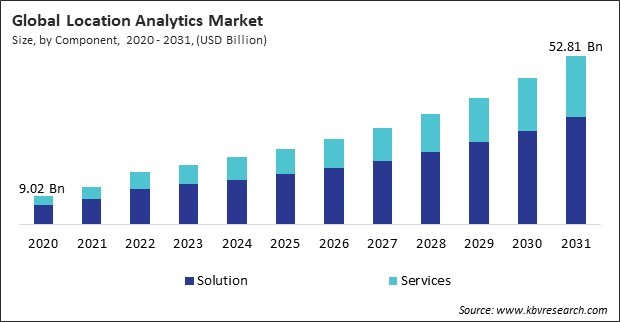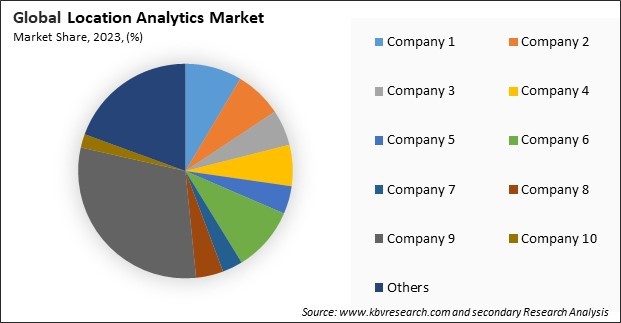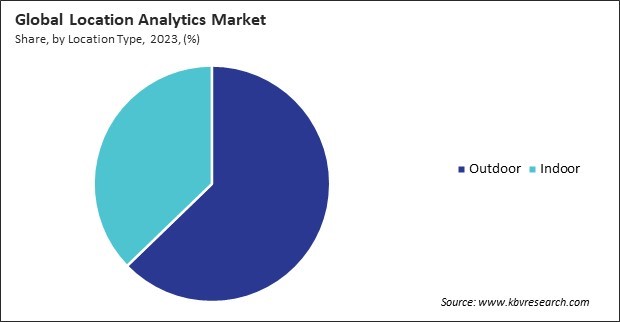“Global Location Analytics Market to reach a market value of USD 52.81 Billion by 2031 growing at a CAGR of 14.1%”
The Global Location Analytics Market size is expected to reach $52.81 billion by 2031, rising at a market growth of 14.1% CAGR during the forecast period.
The North America segment garnered 35% revenue share in the market in 2023. The widespread adoption of AI-powered geospatial intelligence, IoT-based tracking, and real-time location analytics across transportation, retail, BFSI, and defense industries drives the North America segment. The region's strong technological infrastructure, government investments in smart city initiatives, and rapid advancements in autonomous vehicle deployment have further fueled the demand for location intelligence solutions.

The rapid expansion of Internet of Things (IoT) technology and connected devices has led to an unprecedented surge in location-based data generation. More than 13 billion IoT devices were in use in 2022, according to the World Bank's Digital Progress and Trends Report 2023. These devices are expected to experience a more than twofold increase in popularity between 2023 and 2028, primarily due to the real-time connectivity of 5G technology. IoT-enabled devices, including GPS trackers, smart sensors, wearables, and industrial IoT (IIoT) systems, continuously collect and transmit geospatial information in real-time. Therefore, the ongoing implementation of IoT in location analytics will be instrumental in the promotion of data-driven innovation, the enhancement of efficiency, and the improvement of consumer experiences in the years ahead.
Additionally, Consumers now expect real-time and highly accurate location data for various activities, from ordering food and hailing a cab to finding nearby businesses and navigating unfamiliar areas. The increasing demand for precise geospatial intelligence has prompted businesses to incorporate sophisticated LBS solutions into their digital platforms in order to improve operational efficiency and customer experience. Retail, transportation, and hospitality industries are at the forefront of adopting location-based services to drive engagement and optimize service delivery. Thus, the increasing demand for LBS will drive the growth of the location analytics market.
However, In order to responsibly collect and manage user data, governments and regulatory entities worldwide have implemented stringent legislation. Frameworks like the General Data Protection Regulation (GDPR) in Europe and the California Consumer Privacy Act (CCPA) in the United States impose stringent conditions on businesses handling geolocation data. Organizations must obtain explicit user consent before collecting location information, ensure secure data storage, and allow users to opt out of tracking when requested. Hence, these factors may impede the expansion of the market.

The leading players in the market are competing with diverse innovative offerings to remain competitive in the market. The above illustration shows the percentage of revenue shared by some of the leading companies in the market. The leading players of the market are adopting various strategies in order to cater demand coming from the different industries. The key developmental strategies in the market are Acquisitions, and Partnerships & Collaborations.
Based on component, the market is bifurcated into solution and services. The services segment recorded 33% revenue share in the market in 2023. Many companies, particularly small and medium-sized enterprises (SMEs), lack the in-house technical expertise to implement geospatial intelligence solutions effectively, leading them to rely on professional service providers for deployment, customization, and troubleshooting.
On the basis of location type, the market is classified into indoor and outdoor. The indoor segment witnessed 37% revenue share in the market in 2023. The adoption of indoor positioning systems (IPS), Wi-Fi-based tracking, RFID, and AI-driven spatial analytics has enabled businesses to enhance security, operational efficiency, and user experience. In retail, beacon technology and AI-powered analytics help optimize store layouts, foot traffic flow, and personalized marketing strategies, improving overall sales and engagement.

By deployment, the market is divided into on-premises and cloud. The cloud segment garnered 44% revenue share in the market in 2023. Businesses are increasingly seeking AI-powered, scalable, and cost-effective location analytics solutions that facilitate the efficient processing of real-time geospatial data. This demand is the primary driver of the cloud segment. The adoption of IoT, 5G, and edge computing has significantly enhanced cloud-based analytics, making it the preferred choice for industries requiring remote accessibility, automated software updates, and seamless integration with big data platforms.
On the basis of industry vertical, the market is classified into retail, healthcare, transportation & logistics, BFSI, IT & telecommunications, manufacturing, and others. The transportation & logistics segment procured 16% revenue share in the market in 2023. The increasing demand for real-time fleet tracking, route optimization, and supply chain visibility across industries such as shipping, freight management, ride-hailing, and last-mile delivery services drives the transportation & logistics segment. Businesses rely on AI-powered geospatial analytics, GPS tracking, and predictive logistics solutions to enhance efficiency, reduce operational costs, and improve delivery timelines.
Based on application, the market is segmented into risk assessment & mitigation, customer experience management, sales & marketing optimization, supply chain management, disaster & emergency response management, and others. The sales & marketing optimization segment recorded 15% revenue share in the market in 2023. The segment is expanding due to the growing demand for data-driven marketing strategies, hyper-personalized advertising, and location-based consumer insights. Businesses leverage AI-powered geospatial analytics, geofencing, and real-time location tracking to understand customer movement patterns, foot traffic trends, and purchasing behavior.
Free Valuable Insights: Global Location Analytics Market size to reach USD 52.81 Billion by 2031
Region-wise, the market is analyzed across North America, Europe, Asia Pacific, and LAMEA. The Asia Pacific segment procured 29% revenue share in the market in 2023. Governments and enterprises in China, India, Japan, and South Korea invest heavily in real-time GPS tracking, AI-driven logistics solutions, and geospatial intelligence for urban planning and infrastructure development. The booming retail and telecommunications sectors and the rise of IoT-enabled smart devices and AI-powered customer analytics have further accelerated the demand for location-based analytics technologies across the region, making it a key growth market.
| Report Attribute | Details |
|---|---|
| Market size value in 2023 | USD 18.78 Billion |
| Market size forecast in 2031 | USD 52.81 Billion |
| Base Year | 2023 |
| Historical Period | 2020 to 2022 |
| Forecast Period | 2024 to 2031 |
| Revenue Growth Rate | CAGR of 14.1% from 2024 to 2031 |
| Number of Pages | 478 |
| Number of Tables | 770 |
| Report coverage | Market Trends, Revenue Estimation and Forecast, Segmentation Analysis, Regional and Country Breakdown, Market Share Analysis, Porter’s 5 Forces Analysis, Company Profiling, Companies Strategic Developments, SWOT Analysis, Winning Imperatives |
| Segments covered | Component, Location Type, Deployment, Industry Vertical, Application, Region |
| Country scope |
|
| Companies Included | IBM Corporation, SAP SE, Microsoft Corporation, Oracle Corporation, SAS Institute, Inc., Google LLC (Alphabet Inc.), Hewlett Packard Enterprise Company, Cisco Systems, Inc., Esri, Inc., and Zebra Technologies Corporation |
By Component
By Location Type
By Deployment
By Industry Vertical
By Application
By Geography
This Market size is expected to reach $52.81 billion by 2031.
Growing Adoption Of Iot And Connected Devices are driving the Market in coming years, however, Substantial Privacy And Data Security Concerns restraints the growth of the Market.
IBM Corporation, SAP SE, Microsoft Corporation, Oracle Corporation, SAS Institute, Inc., Google LLC (Alphabet Inc.), Hewlett Packard Enterprise Company, Cisco Systems, Inc., Esri, Inc., and Zebra Technologies Corporation
The expected CAGR of this Market is 14.1% from 2023 to 2031.
The Outdoor segment captured the maximum revenue in the Market by Location Type in 2023, thereby, achieving a market value of $32.4 billion by 2031.
The North America region dominated the Market by Region in 2023, and would continue to be a dominant market till 2031; thereby, achieving a market value of $17.7 billion by 2031.
Our team of dedicated experts can provide you with attractive expansion opportunities for your business.

 Drivers
Drivers
 Restraints
Restraints
 Opportunities
Opportunities
 Challenges
Challenges
